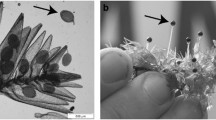Summary
Computer simulation was used to compare the simulated response to doubled-haploid (DH) mass selection with the response predicted by mathematical formulae. The efficiency of DH versus diploid mass selection in a cross-fertilized species was also studied by means of theoretical consideration and computer simulation. Simulated gain was in agreement with the predicted gain in the DH population under both additive and complete dominance models. The simulated variance of response to DH mass selection was close to the predicted variance at both the 5% and 25% selection regimes under additive and complete dominance models. The efficiency of DH over diploid mass selection was shown to be dependent upon the allelic frequency, the degree of dominance, and the amount of environmental variance. In theory the efficiency can range from zero to infinity, but in reality it should be greater than one. The efficiency ranges from √2 to 2 in the absence of dominance; it can be greater than two only in the presence of dominance and a small environmental variance. The variance of response to DH mass selection can be smaller than or up to twice as large as the variance of response to diploid mass selection. Computer simulation results agreed with the predicted efficiency of DH mass selection and with the predicted variance-of-response ratio of DH mass selection to diploid mass selection.
Similar content being viewed by others
References
Baker RJ (1971) Theoretical variance of response to modified pedigree selection. Can J Plant Sci 51:463–468
Chase SS (1952) Production of homozygous diploids of maize from monoploids. Agron J 44:263–267
Choo TM, Kannenberg LW (1978) The efficiency of using doubled haploids in a recurrent selection program in a diploid, cross-fertilized species. Can J Genet Cytol 20:505–511
Choo TM, Kannenberg LW (1981) Comparison of predicted and simulated responses to mass selection in a diploid, cross-fertilized species. Can J Plant Sci 61:1–8
Empig LT, Gardner CO, Compton WA (1972) Theoretical gains for different population improvement procedures. Univ Nebraska Agric Exp Stn Bull Mise Publ 26 (revised)
Griffing B (1975) Efficiency changes due to use of doubled-haploids in recurrent selection methods. Theor Appl Genet 46:367–386
Hill WG (1974) Variability of response to selection in genetic experiments. Biometrics 27:293–311
Vasil IK (1980) Androgenetic haploids. In: Vasil IK (ed) Perspectives in plant cell and tissue culture. Academic Press, New York, pp 195–223
Author information
Authors and Affiliations
Additional information
Communicated by K. Sittmann
Joint Contribution from the Charlottetown Research Station, contribution no. 604 and Department of Crop Science, University of Guelph
Rights and permissions
About this article
Cite this article
Choo, T.M., Kannenberg, L.W. Selection response and efficiency of doubled-haploid recurrent selection in a cross-fertilized species. Theoret. Appl. Genetics 75, 410–414 (1988). https://doi.org/10.1007/BF00276743
Received:
Accepted:
Issue Date:
DOI: https://doi.org/10.1007/BF00276743




